Today, more and more, we hear about credit, debit, prepaid, and revolving cards. All systems that make it possible to pay acquisitions quickly and easily. But is this really the case? What are the differences between one type of paper and another? Let’s try to understand it together.
The debit card -or ATM-is the card with which you withdraw cash from the ATM and make your payments. These transactions are charged directly to your bank account. The limit you can withdraw is set by contract and within the limits of your account availability.
The credit card is generally offered to you as an additional service to your c/c. It allows you to withdraw cash from the counter (an operation called “cash advance”)or purchase products and defer payment within the next month. The amount is debited from your account on the day stipulated in the contract (between the 5th and the 15th of the month following the purchase or withdrawal).
The prepaid card allows you to purchase goods in an amount equal to the amount you have previously deposited on the card. Useful for online purchases since you can predict the maximum amount you can spend. Spend only as much as you have planned and disbursed!
A revolving credit card is issued by a bank or financial institution and allows you to installment the payment of goods purchased or withdrawals made at an an additional charge , within a maximum credit line amount. The rates charged for this installment are very high! If the account balance exceeds the overdraft amount, the customer must also pay a maximum overdraft fee.


